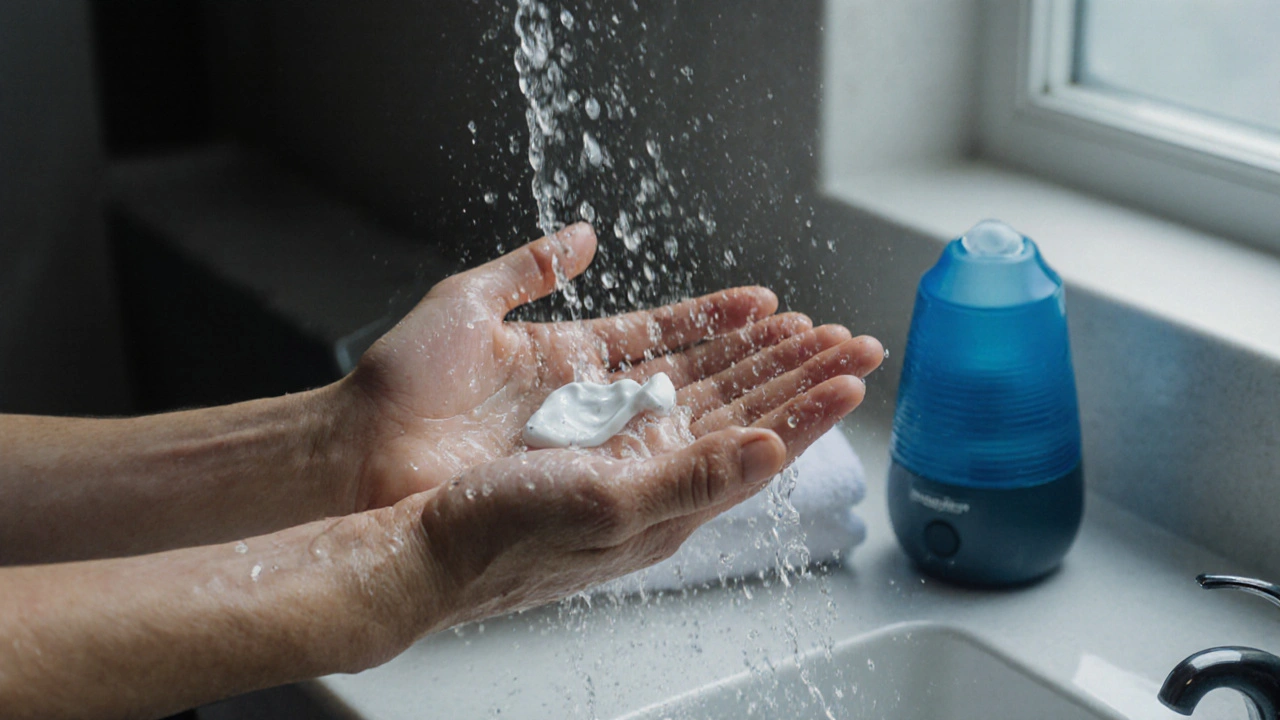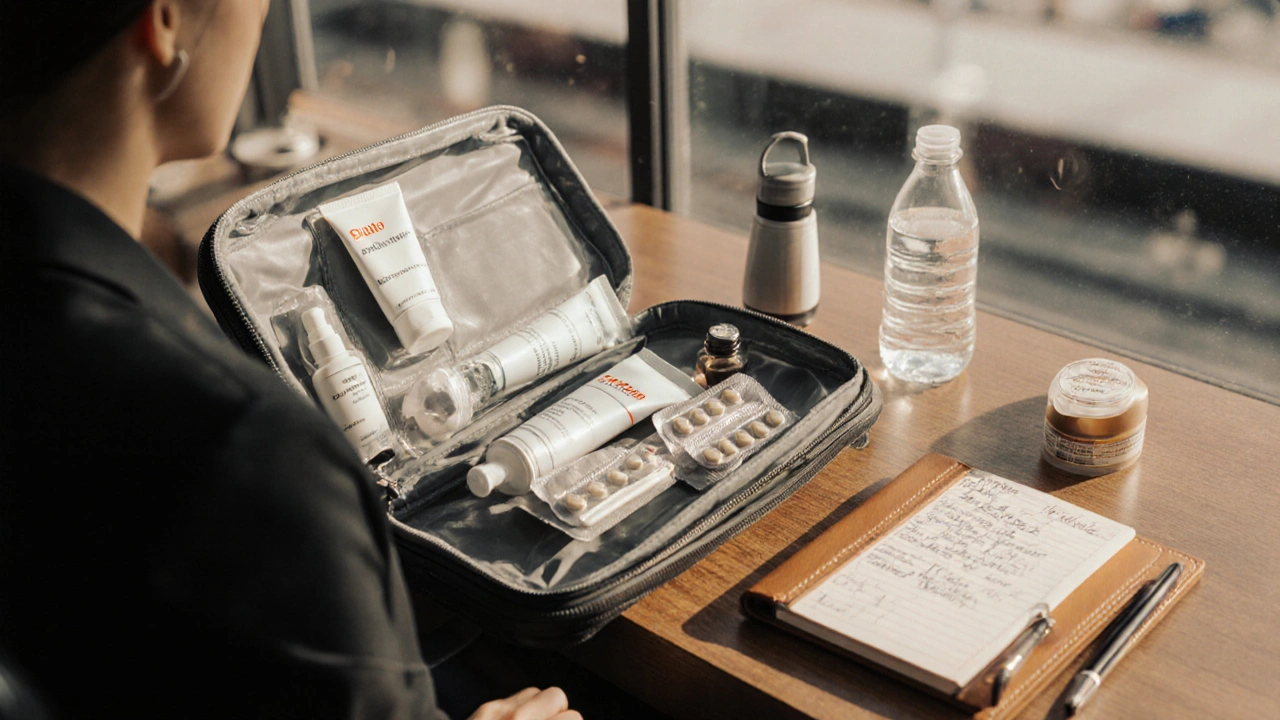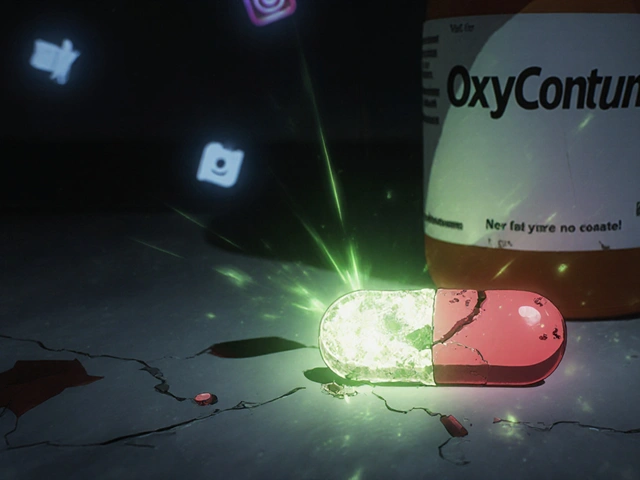Skin Inflammation Travel Planner
Identify Your Triggers
Select the factors that commonly affect your skin when traveling:
Your Travel Kit
Check off the essential items for managing skin inflammation on the go:
Low-dose steroid for quick inflammation relief
Ceramide-rich formula to restore skin barrier
Oral medication for itch relief
Petrolatum-based product for protection
Mineral sunscreen to prevent UV-induced flares
Organize and protect your kit
On-The-Go Treatment Steps
Follow these simple steps when skin inflammation flares up:
Travel Tips Summary
Hydration: Drink at least 2 liters of water daily to maintain skin elasticity.
Humidify: Carry a travel humidifier or place a bowl of water in your room.
Clothing: Choose soft, breathable fabrics like cotton or bamboo.
Sun Protection: Apply mineral sunscreen 15 minutes before going out.
Stress Management: Practice breathing exercises or meditation to reduce histamine release.
When you’re hopping between time zones, the last thing you want is a flare‑up that steals your vacation vibe. Skin inflammation is a broad term covering conditions like eczema, psoriasis and allergic contact dermatitis. It shows up as redness, itching, swelling or painful bumps-symptoms that can flare whenever the environment changes. The good news? With a bit of planning and the right on‑the‑spot tactics, you can keep those flare‑ups in check and still enjoy the journey.
Quick Take
- Identify personal triggers before you leave.
- Pack a lightweight skin‑care kit featuring a low‑strength steroid, moisturizer, and antihistamine.
- Use humidity tricks on planes and in dry hotels.
- Apply barrier creams before exposure to sun, wind, or irritants.
- Seek professional help if symptoms last longer than 48hours or worsen.
Know Your Triggers: What Sets Off Inflammation on the Road?
Travel introduces a cocktail of stressors that can aggravate Eczema or other dermatitis forms. Common culprits include:
- Dry cabin air - airplane humidity often drops below 20%.
- New fabrics - cheap hotel blankets or synthetic socks can irritate sensitive skin.
- Sun exposure - UV rays break down the skin barrier, especially on beaches.
- Water quality - chlorine in pools or hard tap water can strip natural oils.
- Stress and irregular sleep - both boost histamine release.
Pinpoint which of these apply to you by keeping a short journal on the first few days of any trip. Note any itching, redness, or swelling and what you were doing at the time. This data becomes your personal trigger map, essential for proactive management.
Build a Travel‑Ready Skin Kit
A compact, well‑thought-out kit can be the difference between a calm day and a frantic scramble for a pharmacy. Here are the core items, each chosen for effectiveness, size and travel‑friendliness:
- Hydrocortisone 1% cream - a low‑dose steroid that calms inflammation within hours. Choose a 15‑gram tube to fit in a carry‑on.
- Fragrance‑free moisturizer - pick a ceramide‑rich formula that restores the lipid barrier without greasiness.
- Antihistamine tablets - oral diphenhydramine or cetirizine for overnight itch relief when topical measures aren’t enough.
- Barrier cream or ointment - a thick petrolatum‑based product that locks moisture in and shields against wind or irritants.
- Travel‑size sunscreen (SPF30+ mineral) - protects against UV‑induced flare‑ups.
- Reusable silicone travel pouch - keeps everything organized and leak‑proof.
Pack these items in a clear zip‑lock bag, which makes security checks smoother and gives you quick visual access when you need to treat a sudden flare.
On‑The‑Go Relief: Step‑by‑Step Action Plan
When you feel the first tingle of itching, follow this rapid response routine. Each step uses an item from your kit and takes less than a minute.
- Cool it down: splash the area with cool (not icy) water for 30 seconds. Cold water contracts blood vessels, reducing swelling.
- Pat dry: gently blot the skin with a soft towel; avoid rubbing, which can worsen irritation.
- Apply a thin layer of hydrocortisone: use a pea‑sized amount for each affected spot. Spread evenly.
- Seal with moisturizer: once the steroid absorbs (about 2 minutes), lock in moisture with a fingertip of ceramide cream.
- Cover if needed: for exposed areas like hands, apply a barrier ointment on top to protect against wind or friction from bags.
- Take an antihistamine (optional): if itching persists into the night, a single oral dose can help you sleep.
Repeat this routine every 8‑12hours until the flare subsides. If redness spreads beyond the original area or you develop pus, it’s time to seek medical advice.

Choosing the Right Topical: A Quick Comparison
| Product | Active Ingredient | Strength | Best Use Case |
|---|---|---|---|
| Hydrocortisone Cream | Hydrocortisone | 1% | General flare‑up, quick anti‑inflammatory action |
| Calamine Lotion | Zinc Oxide & Iron Oxides | 0.5% | Mild itching from insect bites or contact dermatitis |
| Barrier Ointment | Petrolatum | 100% | Prevent moisture loss in dry climates or after washing |
| Antihistamine Cream | diphenhydramine | 2% | Night‑time itch relief for sensitive skin |
Pick one based on your specific symptoms. Hydrocortisone wins for fast inflammation control, while barrier ointments excel at long‑term protection, especially on long flights where cabin air is dry.
Travel Hacks to Keep Your Skin Calm
Beyond the kit, a few lifestyle tweaks can dramatically lower flare risk.
- Hydration: drink at least 2liters of water daily. Dehydration reduces skin elasticity and exacerbates itching.
- Humidify: carry a collapsible travel humidifier for hotel rooms, or place a bowl of water near the heater to add moisture.
- Clothing choices: Opt for soft, breathable fabrics like cotton or bamboo. Avoid wool or synthetic blends that trap heat.
- Sun protection: Apply mineral sunscreen 15 minutes before heading outdoors, then reapply every two hours.
- Stress management: Simple breathing exercises or a short meditation app can lower histamine release.
These habits don’t require extra luggage, just a bit of foresight.
When to Seek Professional Help
Most travel‑related flare‑ups resolve within 48hours with proper self‑care. However, look for red flags that warrant a doctor’s visit, especially if you’re far from home.
- Symptoms persist beyond two days despite treatment.
- Swelling spreads rapidly or involves the eyes, lips, or throat.
- Fever, chills, or oozing pus appear.
- You’re on medication that may interact with steroids (e.g., blood thinners).
If any of these arise, locate the nearest urgent‑care center or contact a tele‑dermatology service. Having a copy of your medical history and a list of current medications speeds up the consultation.
Pre‑Trip Checklist
- Research climate and water quality of your destination.
- Confirm that all kit items comply with airline liquid restrictions (<5ml per container, placed in a 1‑liter zip‑lock).
- Print a one‑page summary of your skin condition, typical triggers, and emergency contacts.
- Schedule a brief check‑in with your dermatologist 2‑3 weeks before departure.
- Pack a small resealable bag of cotton swabs and hypoallergenic wipes for quick cleaning.
Running through this list before you zip up your suitcase turns a potential nightmare into a smooth, confident travel experience.
Frequently Asked Questions
Can I use prescription steroids while traveling?
Yes, but bring a copy of the prescription and keep the medication in its original packaging. Some countries require a Doctor’s note, so check the entry requirements of your destination.
Is it safe to rely solely on over‑the‑counter creams?
For mild to moderate flare‑ups, OTC options work well when paired with good skin‑care habits. Severe or widespread inflammation still needs professional evaluation.
How often should I reapply moisturizer on a long flight?
Aim for every 3‑4hours, especially after using the restroom or washing your hands. A small dab protects against the dry cabin air.
What if my skin reacts to the airline’s disinfectant wipes?
Wipe the surface with a damp cloth before using it, or carry your own alcohol‑free wipes. A barrier cream applied beforehand can also guard against irritants.
Should I avoid swimming in pools while my skin is inflamed?
If the water is heavily chlorinated, it can dry out already irritated skin. Rinse off immediately after swimming and reapply moisturizer.





Wow, this guide is like a travel buddy for your skin! I love how it breaks down the triggers so you can actually anticipate them before they ruin your trip. Packing that tiny moisturizer and a mini humidifier can really save the day. Keep those vibes high and the flakes low!
Honestly, who needs all those fancy creams when you can just stick to plain ol' petroleum jelly? It works just fine for us patriots who don't trust fancy imports.
Sure, the checklist looks neat, but most of us just wing it and hope for the best. Travel is about adventure, not a skincare routine.
I get the excitement, but remember that the cabin air can be a nightmare for eczema. A quick splash of cool water before you apply the hydrocortisone can really calm the itch. Also, try to pat the skin dry instead of rubbing – it saves you from extra irritation. Keep a small, soft towel in your carry‑on; it’s a game‑changer.
From a dermatological perspective, the protocol outlined aligns with evidence‑based practices for acute flare management. Hydrocortisone 1% remains the gold standard for rapid anti‑inflammatory action in mild‑to‑moderate presentations. Incorporating a ceramide‑rich emollient post‑steroid optimizes barrier restitution, thereby reducing recurrence risk. Additionally, the recommendation to avoid occlusive dressings unless necessary mitigates maceration phenomena. Overall, the algorithm is sound and operationally feasible for travelers.
Nice rundown! I usually just toss the moisturizer in my side pocket and forget about the humidifier, but this reminded me to give it a try. The silicone pouch idea is slick – no leaks at security.
Great tips for staying itch‑free on the road.
Your checklist is well‑structured, but watch out for the liquid limits when packing hydrocortisone. A travel‑size tube usually passes security without issue.
Exactly! And don’t forget to stay hydrated-water is the ultimate skin‑soother!!! Carry a reusable bottle and sip frequently; your skin will thank you.
Minor typo: “ceramide‑rich” should be hyphenated. 👍
I appreciate the thoroughness of this guide. It balances practical advice with medical rationale, which is commendable.
Let me take a moment to dissect this whole travel skin‑care thing because, honestly, it’s more layered than a lasagna. First, you have the environmental triggers that act like the villains in a blockbuster movie-dry cabin air, aggressive sunlight, questionable water quality, and the ever‑present stress that sneaks in like a plot twist. Second, the proposed counter‑measures read like a superhero squad: hydrocortisone, moisturizers, antihistamines, barrier creams, and sunscreen all lined up in perfect formation. Third, the timing is crucial; the guide suggests a cool‑down splash, which is basically the ice‑breaker of dermatology, followed by pat‑drying-because rubbing is the villain’s sidekick. Fourth, the steroid application is a low‑dose hero, just enough to calm the inflammation without turning your skin into a courtroom drama. Fifth, sealing with moisturizer locks in that peace treaty, sealing the skin barrier like a diplomatic agreement. Sixth, the optional antihistamine is your night‑shift guard, ensuring you don’t lose sleep over itching. Seventh, the humidifier tip is clever-adding moisture to the air is like installing air‑conditioners in a desert. Eighth, hydration through water consumption is the foundation, the base camp for any expedition. Ninth, clothing choices are paramount; breathable fabrics are the armor that lets your skin breathe. Tenth, sun protection with mineral sunscreen is the shield that prevents UV‑induced flare‑ups. Eleventh, stress‑management techniques are the mental gymnastics that keep histamine levels in check. Twelfth, the pre‑trip checklist is the mission brief, making sure you’ve covered all bases before you even board the plane. Thirteenth, the red‑flag section is essential; it tells you when to call in reinforcements-medical professionals, that is. Fourteenth, the travel kit organization tip with silicone pouches ensures you’re not fumbling around in a panic. Finally, the sheer amount of detail, from the exact amount of cream to the timing of each step, reads like an operation order. It’s thorough, it’s practical, and it respects the realities of travel. In short, this guide is a masterclass in preventive dermatology for the wandering soul, turning potential skin catastrophes into manageable hiccups.
Look, the science is simple: keep the skin barrier intact and avoid irritants. If you want to save money, skip the fancy creams and just use plain petroleum jelly. It does the job.
The drama of a flare-up on a foreign shore is like an unexpected thunderstorm-sudden, intense, and unforgettable. Yet, armed with this guide, you become the storm chaser, anticipating the clouds before they gather. Remember, the most powerful weapon is preparation, not panic.
Stay calm, follow the steps, and you’ll keep the itch at bay.
Absolutely! Adding a quick breath‑focus session before you apply the cream can amplify the soothing effect-science meets mindfulness. Keep the routine tight and your skin will thank you!
Great compilation! Just a heads‑up: double‑check airline regulations for liquid volumes to avoid any surprises at security.